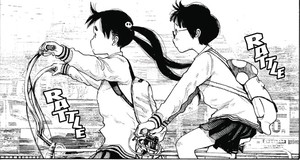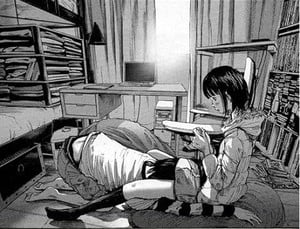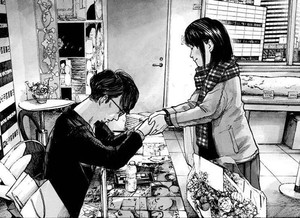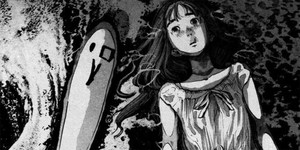Curated From www.animenewsnetwork.com Check Them Out For More Content.
Inio Asano may be one of the creators whose works don’t allow for middle-ground opinions. There’s something in the reactions to his work that smacks of “love it or hate it,” with readers either fully embracing his dark, psychological style of storytelling or decrying it as something that tries too hard to be edgy. Scroll through the Goodreads page for A Girl on the Shore as an example of the phenomenon and you’ll find that most reviews are either five stars or 1/DNF (did not finish); the pages for any random volume of Goodnight Punpun will yield similar results. Goodreads and its ilk are hardly the gold standards for discovering quality literature, but it’s still an interesting experience to see the vast spread of opinions on Asano’s manga, and how very clustered those opinions are the ends of the rating spectrum.
Asano, who in 2010 was described by Japanese newspaper Yomiuri Shimbun as “one of the voices of his generation,” writes stories that blend dark magic realism with what feels very like Millennial malaise – the discomfort of a generation that was promised the same things their parents had only to begin working at a time when those were no longer easily attainable. If this sounds like generational whining, that’s a fair assessment, and in a 2018 interview with us, Asano himself remarked “You can say that millennials in Japan are jaded and less motivated, but if you break it down further, you can say this generation does not expect much for the future and what they consider ‘happiness’ is different from past generations.” None of this is to say that Asano’s characters aren’t looking for happiness. Unlike their bright-eyed manga peers, they’re focused on a different kind of fulfillment, one that takes on myriad forms across Asano’s many stories.
Although this theme is present in most (if not all) of his works, 2014-2022’s Dead Dead Demon’s Dededededestruction is a particularly good example of it. Three years before the story opens, aliens invaded the earth, but when we join the plot, that’s become old news.

©VIZ Media, LLC
The protagonists of the series, two high school girls, are just living their lives as they always have. The aliens’ arrival was cause for alarm at first, but as time wore on, it just became another fact of life; we could almost draw a parallel between that and the Covid-19 pandemic. Rather than becoming a sprawling science fiction epic, the series is an exploration of human nature and relationships, showing how we all adapt to disruptions and find ways to just keep on keeping on. It encompasses the statement quoted above, with Kadode and Ouran simply focusing on a slightly different future than the one they spent most of their lives expecting. There’s a distinct lack of hot-blooded shounen or seinen action to vanquish the invaders, but neither is there a dreamy or emotional shoujo or josei sense of romantic yearning. There are bits and pieces because those are basic human emotions painted large as genre tropes, but they’re just elements of the story rather than the reason for it.
Human relationships and their many shapes form a thread through Asano’s works, and two of the most interesting on that front are A Girl on the Shore and Downfall, one written before Dead Dead Demon’s Dededededestruction and the other in the middle of it. A Girl on the Shore is almost certainly the more infamous of the two because much of its page count is taken up by graphic sex scenes between two middle schoolers.

©Vertical
(Not surprisingly, this is often cited by readers as why they didn’t like it.) But lest you think it’s exploitative, the sex does serve a point: it’s a way for the characters to find a connection while simultaneously rebelling against expectations. Both of them are haunted by things in their past, and I think it would also be fair to say that they’re grappling with mental illness, with his being more obvious in the text than hers. Mostly they’re looking for a connection, and if they can’t find it socially or emotionally, physically will have to suffice. There’s nothing healthy about their liaison in a way that has zero to do with their ages; we’d damn it as “unhealthy” if they were in their thirties. But there’s something emotionally honest about their interactions – they both are fully aware of what they’re doing and why they’re doing it, and their drive to explore what their bodies can do and feel is very grounded in what is a reality for many allosexual teens. And they do care for each other in a way that has nothing to do with romance. Much as the aliens are just a plot device in Dead Dead Demon’s Dededededestruction, sex is just a way for Isobe and Sato to work through their issues.
It plays a similar role in Downfall, albeit in a much more destructive way. Kaoru, the protagonist of that story (or at least the point of view character; he could charitably be said to be both protagonist and antagonist), has a history of viewing women as sexual objects, with the only “woman” he has a decent relationship with being his cat, although even that is fraught because of his initial encounter with a woman with cat-like eyes.

©VIZ Media, LLC
Kaoru’s eponymous Downfall is brought about by his relationships with sex and women and his difficulties with his career as a manga creator. Like the adults in Dead Dead Demon’s Dededededestruction, Kaoru is mired in the grim realities of his world, in his case the idea that he may need to just start seeing manga as work rather than a creative field he takes pride in. For him, treating women as sexual objects is about exerting control, whereas the mutual relationship in A Girl on the Shore frames it as a way to find mutual human contact. These differences again highlight the generational gap we see across Asano’s works: the older adults are jaded and discouraged, while the younger characters are just getting by day-to-day, because, as Asano said, the younger generations don’t have the same expectations of the future. Why plan when you can’t even be sure that there’ll be a world left in thirty years?
Perhaps none of his works encapsulate this as well as Goodnight Punpun. Unrelentingly grim, the story follows Punpun’s hard-luck life as he saves his elementary school crush Aiko his entire world, only to realize at the end that he’s been a ghost in his existence. It takes the crushing nihilism of Downfall, the unhealthy relationship of A Girl on the Shore, and the uncertain (and possibly unwanted) future of Dead Dead Demon’s Dededededestruction and combines them into what feels like the most “Asano” of all his series. (Bits and pieces can also be tied to What a wonderful world!, Nijigahara Holograph, and Solanin as well, particularly the ending of that last one.) In some ways, that also makes Goodnight, Punpun Asano’s most difficult series; Dead Dead Demon’s Dededededestruction is roughly as long, but its hopeful elements, although couched in ennui, are still more easily seen.
One of the most striking elements of the series is the way that Punpun himself is always drawn as a cartoon bird. We see glimpses of his human body – notably when he’s raped by an older woman – but he’s drawn as Other for the majority of the series’ run.

©VIZ Media, LLC
This makes him an intriguing combination of human and alien, with the question being which identity is his own and which is the one given to him by the people he interacts with. Given his relationships with most people, it seems likely that the bird is the way he sees himself; he’s on the outside looking in, but that may also give him the power (or “power”) to believe that he can save Aiko. He’s not a literal alien like the ones in Dead Dead Demon’s Dededededestruction, but that’s how he views himself, with Aiko’s death in the final volume and his survival forcing him back into a human body. Even though Punpun lives in the literal sense that he’s still breathing, his bird self has died with Aiko, meaning that the future he saw for himself has ended. Is that hopeful? Not necessarily, because human Punpun is just as lost as he ever was. But he’s been forced to see that there is a future.
If there’s one final defining element of Inio Asano‘s works, it is that: there is always a future, one way or another. His younger characters may lean into the idea that there won’t necessarily be one, but every concrete ending (typically a death) leads to yet another possibility. There are concrete finales for some characters, but those left behind are forced to recognize that there is just a hidden bend in the road rather than a dead end. The girl on the shore is found, the band plays on, and the aliens’ mothership just hovers over all. In Asano’s stories, the future exists for just a little while longer, while the characters all try their best to keep moving towards it in their way.

